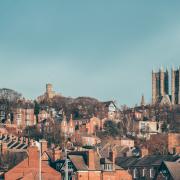Flower power rescues a gloomy Calder Valley town. Richard Darn explains

Yorkshire is full of stereotypes according to outsiders. We are gritty, dour and tight with our cash. You know the kind of nonsense I’m talking about. These supposed traits are rooted in the mists of time, but it’s surprising how quickly something or somewhere can become defined by a single word. So for me in my lazy way, Hebden Bridge means hippy and I suspect it does for countless others who don’t live there.
I arrived back in ‘Trouser Town’ (as it was dubbed during the heyday of its textile trade) ready to put such simplistic thinking behind me and what do I discover? An exhibition staged by the local history society entitled ‘How hippies changed Hebden Bridge’. This wonderful little show is now over, but the organisers have put much of the material online so you can discover the story while sipping your mocha on the banks of the revitalised Rochdale Canal.
Let me take you back in time to the 1970s. You couldn’t buy a clove of garlic in Hebden Bridge, the town was being drained of its young people, soot coated the crumbling buildings many of which were scheduled for demolition and the mills were closing. The local paper reported that a lecturer was shouted down when he suggested the Calder Valley should be ‘phased-out’, but that was happening anyway with the population shrinking at the rate of 10 percent in a little over a decade.
Who would have thought that the answer to the malaise would be a bunch of free loving, long haired folk who came in search of a greener life? Not that their regenerative potential was recognised as such at first. One councillor told a meeting: ‘the behaviour of the long-haired section of the community deteriorates year by year … we are trying to attract visitors to our town, but we do not need this sort of thing.’ A more conciliatory colleague reminded him that hair grew outward and did not reflect what was under the scalp.
By the mid-1970s nearly 1,000 houses in Hebden Bridge were listed for demolition with the owners receiving as little as £8 in compensation. Some of the condemned properties were occupied by squatters, initially creating more friction, but other councillors helped the incomers get home improvement grants. More New Age travellers arrived called the Tepee People with goats in tow, but their behaviour proved far more disruptive and threatened the embryonic relationship between valley dwellers and hippies. Their departure in the direction of Burnley was a relief to all concerned and got things back on an even keel.
Hippies also brought their energy and creativity to what was becoming a moribund place. Photographic studios, clothing workshops, music and arts venues put counter culture zest into the valley’s cultural life. And of course they also brought organic food! Aurora Wholefoods was set up in the early 1970s and became a workers co-operative stocking staples such as porridge, brown rice and lentils with customers travelling from up to 40 miles away. (You could even buy a garlic bulb!)
In doing so they began to cultivate our modern taste for local produce rather than mass produced food with an eye on sustainability. A walk down the high street in Hebden Bridge reveals the lasting impact they’ve had. I am pretty much impressed by everything I read and see in the exhibition.
It’s clear the town’s renaissance has been from the bottom up and a good way of looking at the hippies’ contribution is to think what would have happened had they not come in their clapped-out VW campers from the likes of Manchester, Basingstoke and Leeds. The bulldozers would have moved in and the town would have been saddled by the same ugly developments that scar so many other fine old Yorkshire settlements. The town’s unique character would have been diluted rather than embellished and instead of being a top tourist destination it might have become a ‘oh hum’ sort of place to avoid if possible.
Former squats are now part of desirable neighbourhoods and the town is an aspirational place to live for many people and the de facto capital of the South Pennines. Head over to the website hebdenbridge.co.uk and download the free booklet tracing this rags to riches story and hear from the hippies themselves, many of whom are now grandparents and pillars of the community.
The creativity let loose in Hebden Bridge in the 1970s has flowed up and down the Calder Valley. Todmorden gave birth to the now global Incredible Edible organic food movement and making a name in the arts are four young people who set up a business called Sand in Your Eye. They have just opened their first workshop in nearby Mytholmroyd where groups, children and even firms on corporate outings come to learn the skills of creating fabulous sand and ice sculptures. You might have seen some of their amazing art work in city centres across the UK (a head sculpture used 20 tonnes of sand!) and one of their most high profile commissions was creating 9,000 human sand figures on the Normandy D Day beaches depicting those who fell in the allied invasion of Europe on June 6th,1944. Visit their website sandinyoureye.co.uk to see more of their stunning work.
It’s a singular achievement that a valley once losing its young people at a rate of knots is now a place bursting with ideas and attracting the brightest and the best. Time to raise a glass of nettle wine to the hippies.



























